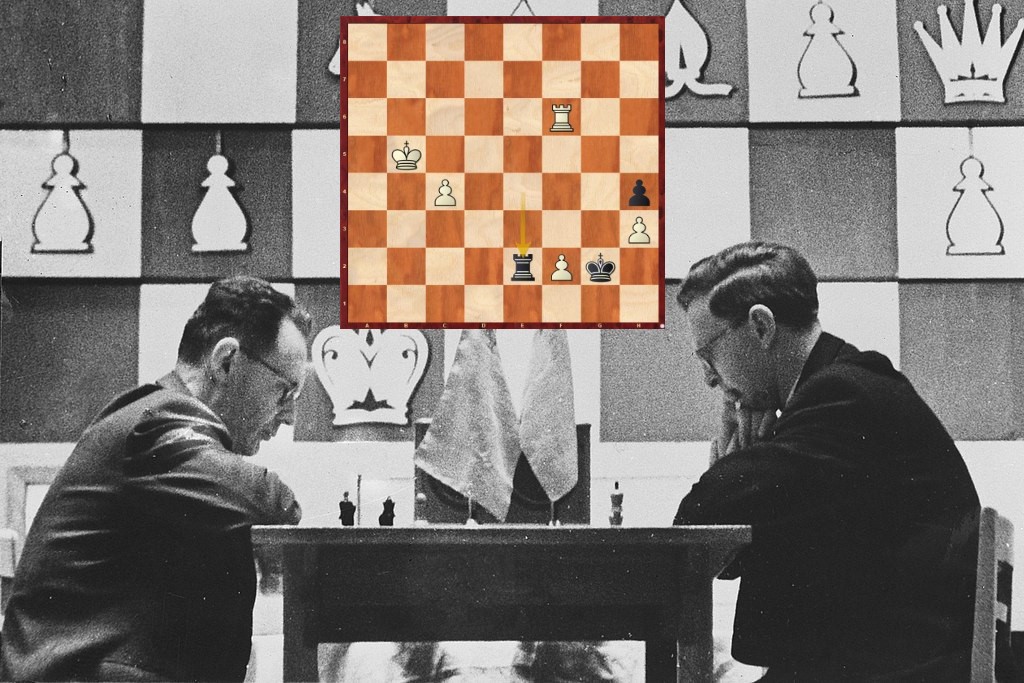The drawish nature of rook endings
Mikhail Botvinnik became world champion for the first time in 1948. The Patriarch of Soviet chess defended the title twice, first against David Bronstein (1951) and then against Smyslov (1954). In 1957, he was defeated by a 33-year-old Smyslov, who obtained a clear 12½:9½ victory in Moscow. Then came the 1958 rematch. Botvinnik faced Smyslov once again in a 24-game match, and kicked off with three straight victories — he would go on to win the match 12½:10½.
We presented a riddle from the rematch, thanks to a suggestion made by JNorri, who wrote: “For the future: I would suggest the 14th game of the 1958 Smyslov-Botvinnik match. Botvinnik called it maybe his most subtle rook ending.”
Even Botvinnik’s “most subtle” rook ending was drawn almost until the end, as the ChessBase readers found out!
 Once again, Zoran Petronijevic sent the best solution, explaining in detail why Black cannot defend. These were his conclusions:
Once again, Zoran Petronijevic sent the best solution, explaining in detail why Black cannot defend. These were his conclusions:
- The position after 22...Re6 is even.
- The game was adjourned after 41.Rh8. Botvinnik in his comments (his latest comments on this game are from 1986) points out that he had found a deep plan for him. However, the position is still even.
- Botvinnik criticizes 43...Kg6, which is in fact a good move and leads to even play.
- According to Botvinnik, 46...Rd6 loses. In fact, it leads to a very interesting pawn endgame, which is a draw. Botvinnik thought that 46...Ke6 loses due to 47.Rd4 — Charles Sullivan pointed out that this position is still even.
- Very interesting is 52...f4. According to Botvinnik, the position is already lost and Smyslov tried to confuse him by making the position more complex. Mikhalchishin has a different opinion: the position is still holdable, although f4 is a dubious move. In my opinion, this was a normal move.
- The first real mistake in this game is 54...Kf3. This move leads to a losing position. Neither Botvinnik nor Mikhalchishin evaluate it as a mistake. After 54...Re1 Black can hold.
- Botvnnik was right when he wrote that 57.axb5 is a mistake. Better was 57.Rxa6. In his analyses there are some mistakes.
- The decisive mistake is 59...Re2. Botvinnik thought that only 59...Re1 leads to draw, and 59...Kxh3 loses. The truth is that both moves lead to draw (see analyses).
A very complex game with a lot of small imprecisions, which are unavoidable in this kind of positions.
In over 4 hours in front of the camera, Karsten Müller presents to you sensations from the world of endgames - partly reaching far beyond standard techniques and rules of thumb - and rounds off with some cases of with own examples.
In our replay board above there are a large number of functions you can use to really understand the game and the analysis. Recently we published a comprehensive tutorial plus video instructions which tells you about all the powerful features and buttons that make the ChessBase's replay one of the best replay experiences around.
One big advantage is that you can start an engine (fan icon) that will help you to analyse. You can get multiple lines of analysis by clicking the + button to the right of the engine analysis window. The "!" key, incidentally, shows you the threat in any position, which is incredibly useful in the case of unclear moves.
 There is one more thing you can do. It is a lot of fun, but also a serious challenge: Click on the rook icon below the notation window. This will allow you the play the above position against Fritz, at your level of playing strength (e.g. "Club Player"), right here on the news page. Note that your analysis, in which you can delete, move or promote lines, is stored in the notation as new variations. In the end you will find the game with your analysis in the cloud. So nothing is ever lost.
There is one more thing you can do. It is a lot of fun, but also a serious challenge: Click on the rook icon below the notation window. This will allow you the play the above position against Fritz, at your level of playing strength (e.g. "Club Player"), right here on the news page. Note that your analysis, in which you can delete, move or promote lines, is stored in the notation as new variations. In the end you will find the game with your analysis in the cloud. So nothing is ever lost.
Links


















 Once again, Zoran Petronijevic sent the best solution, explaining in detail why Black cannot defend. These were his conclusions:
Once again, Zoran Petronijevic sent the best solution, explaining in detail why Black cannot defend. These were his conclusions: There is one more thing you can do. It is a lot of fun, but also a serious challenge: Click on the rook icon below the notation window. This will allow you the play the above position against Fritz, at your level of playing strength (e.g. "Club Player"), right here on the news page. Note that your analysis, in which you can delete, move or promote lines, is stored in the notation as new variations. In the end you will find the game with your analysis in the cloud. So nothing is ever lost.
There is one more thing you can do. It is a lot of fun, but also a serious challenge: Click on the rook icon below the notation window. This will allow you the play the above position against Fritz, at your level of playing strength (e.g. "Club Player"), right here on the news page. Note that your analysis, in which you can delete, move or promote lines, is stored in the notation as new variations. In the end you will find the game with your analysis in the cloud. So nothing is ever lost.




